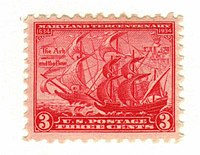The Ark (ship)

"Ark" and the "Dove", shown here in a 1934 U.S. commemorative postage stamp
|
|
| History | |
|---|---|
|
|
|
| Name: | Ark |
| Owner: | Hired by Cecilius Calvert, second Baron or Lord Baltimore, (1605-1675) |
| Launched: | c. 1630 |
| General characteristics | |
| Tons burthen: | 400 |
| Length: | Approximately 132 feet on deck |
| Beam: | 32 feet |
| Draft: | 14-15 feet |
| Depth of hold: | 14 feet |
| Propulsion: | Sail |
| Sail plan: | Three masted, Spritsail& spritsail topsail, fore course, fore topsail & fore topgallant, main course, main topsail and main topgallant, Lateen mizzen with square topsail. |
| Complement: | Approximately 40 seamen |
| Armament: | Unknown, but probably capable of mounting 20-25 cannon. |
Ark was a 400-ton English merchant ship hired by Cecil Calvert, 2nd Baron Baltimore (1605–1675), to bring roughly 140 English colonists and their equipment and supplies to the new colony and Province of Maryland, one of the original thirteen colonies of British North America on the Atlantic Ocean eastern seaboard. On the historic trans-oceanic voyage from England in late 1633 and early 1634, Ark was accompanied by the smaller 40-ton pinnace Dove.
After several delays, the two ships sailed from the Isle of Wight off the south coast of England on the 22nd November 1633. Three days later a storm in the English Channel separated 'Ark from Dove. When Dove disappeared from view, she was flying distress lanterns, and those aboard Ark assumed she had sunk in the storm. A second more violent storm hit Ark on 29 November and lasted three days, finally subsiding on 1 December. In the midst of the storm the mainsail was split in half and the crew was forced to tie down the tiller and whipstaff so the ship lay ahull', keeping her bow to the wind and waves as she drifted. This was the last bad weather Ark encountered on the trans-Atlantic voyage.
On the 25th December, wine was passed out to celebrate Christmas. The following day, 30 colonists fell ill with a fever brought on by excessive drinking and 12 died, including two of the Roman Catholic colonists. These were the only losses suffered on the voyage. On 3 January 1633/34, Ark arrived at the island of Barbados in the West Indies after a voyage of 42 days from England. About two weeks later, Dove arrived. As it later developed, Dove had been able to reach the shelter of Plymouth harbour where she rode out the storm.
On 24 January 1633/34, the ships departed Barbados. An earlier departure was intended, but was delayed because Richard Orchard, master (captain) the Dove had departed inland to collect some debts and could not be found on the intended sailing date. After making a few other stops in the Caribbean Sea, on 24 February 1633/34, the ships arrived at Point Comfort (now called Old Point Comfort) at the mouths of the James, Nansemond, and Elizabeth rivers, which formed the great harbor of Hampton Roads in Virginia. This ended their ocean voyage which had lasted slightly over three months, of which 66 days were actually spent at sea. The two ships briefly stopped in Jamestown, Virginia up the James River.
...
Wikipedia
